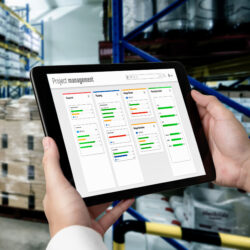IT puzzle requires a holistic approach

I’ve heard the saying ‘Keep it simple, stupid’ many times and have applied it successfully in projects myself. The adage ‘Start simple, create success and build on it’ is in a similar vein and often works very well in the context of change management. The problem is that this is usually far from easy, if real-life supply chain projects are anything to go by. However, when supply chain planning technologies – which are oddly enough often described as ‘advanced planning systems’ – are applied effectively, supply chain transformation programmes can produce fantastic results.
By Henk Jan Rijkse
The correct and complete modelling of supply chains and the subsequent application of planning and optimization technology offers unprecedented possibilities. Just think of true supply chain transparency, accurate simulations and smart plans that can actually be implemented integrally in real life. For example, an ingredients multinational that I have worked with now has true chain-wide insight and can quickly make ‘optimal’ assessments in its production decisions, inventory strategy, allocation choices, sourcing and risk management – all of which are essential in this company’s rapidly changing business context.
In terms of technological content, the crux often lies in correctly defining the supply chain and providing support in making – ideally optimal – plans. The devil is in the detail. And let’s not dwell on the importance of correct master data and the timely availability of correct transaction data, which is often a key challenge.
Speaking of details, I recently had the opportunity to take a very detailed look behind the scenes of a machine learning project. Once again, it proved that state-of-the-art technology alone is not a miracle cure. For example, time-phased data at the lowest level in the supply chain – at store level – was still necessary to correctly determine the impact of weather conditions. On an aggregated level, other factors appeared to have more influence; in fact, taking weather data into account had a disruptive effect.
Rapidly visible success
Whether done intentionally or not, cutting corners to ‘start simple’ ultimately leads to a lot of headaches in a project. It is at odds with all the intelligence in advanced supply chain applications, in which everything can be connected to everything else and where simplifications or errors in one place can immediately make an ‘optimal’ plan impractical or worthless elsewhere. Still, we like to ‘start simple’, and preferably with rapid signs of success.
Given the nature of integral supply chain planning technology, it is important to have a clear overview of the bigger picture in order to realistically assess the impact of temporary simplifications. And that’s difficult if we want to achieve visible success quickly.
Starting simply often also means that users of all those fantastic supply chain systems keep working with all sorts of stand-alone Excel files because some of their information and planning needs are still not being met. That doesn’t foster willingness to work with such wonderful systems and doesn’t help to achieve the desired result either. The aim is often to enable effective integral planning and eliminate all kinds of spreadsheets at local level.
At the aforementioned ingredients company, the supply chain tools only created any real value when they correctly took into account all production processes, the total volume, all detailed (technical) inventory management and allocation options and all interrelationships between the factories. Until that was possible, everyone largely continued using all kinds of Excel sheets and the system was more of a hindrance than a help. Fortunately, the director had a firm and clear vision, plus the patience to realize it. I doubt that the outcome would have been so successful otherwise.
If you want to do things right, this topic is actually too complex to tackle quickly and easily, and at the same time it is too valuable – and often also too costly – to run the risk of an implementation running aground halfway through. In that context, I am always amazed to see so many companies referring to Gartner’s Magic Quadrant when selecting supply chain tools and approaching only a select number of vendors based on their position within it. After all, I believe that a good ‘match’ between vendor and customer – both in terms of project content and approach – is more important for success than making a seemingly ‘safe’ choice… although I am not saying that the various quadrants and supplier insights are not very valuable.
Essential basis
Classics such as the importance of a real need to change, clear and unambiguous objectives, a well-developed vision, a competent and driven team (including ‘doers’ in a project) and active commitment from senior management are – and remain – an essential basis for successful implementation of supply chain planning. If any of these aspects are not right, it will be difficult – if not impossible – to complete the project successfully. However, for a supply chain planning project it is equally important to choose good tools, to perform correct and complete modelling and to arrange the right inputs. If a tool cannot handle certain things, or only at great additional expense, it can be difficult – if not impossible – to successfully integrate them into the daily workflow.
So don’t oversimplify things!
Henk Jan Rijkse is director of Supply Chain Company. He has extensive experience in supporting supply chain transformation programmes and has helped to implement a wide range of supply chain planning systems over the years.









